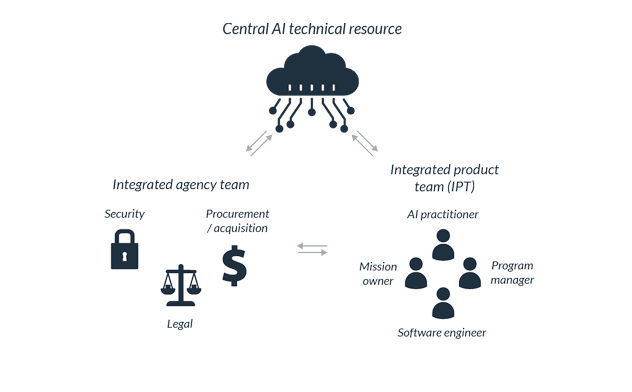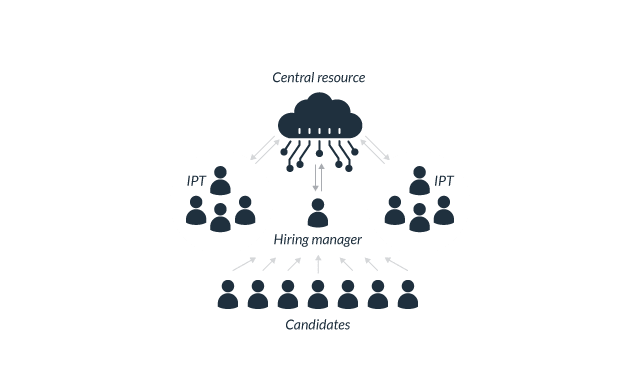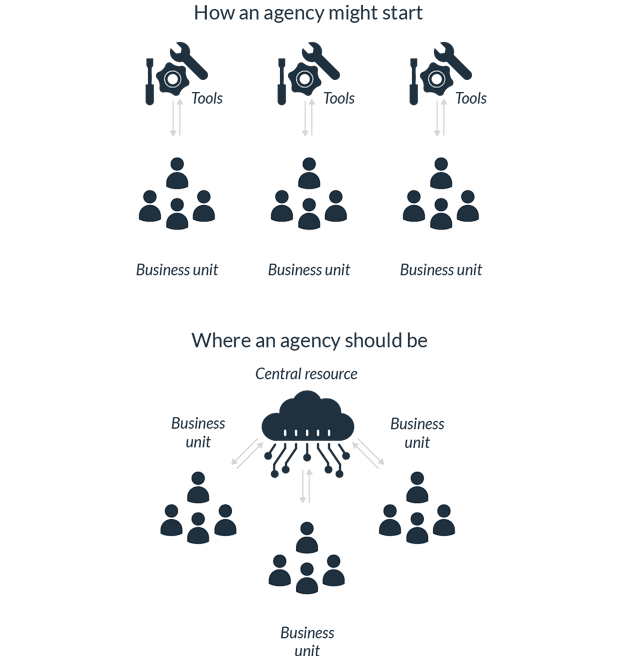The structure for organizing and managing AI should accomplish two broad goals: 1. enhancing mission and business unit abilities to meet their objectives and 2. supporting practitioner effectiveness.
Goal 1: Enhancing mission and business unit ability to meet their objectives means including AI knowledge in mission and program offices
Though each agency is structured slightly differently, the mission units, business units and/or program offices–for the purposes of this chapter, we will call them business units–are primarily responsible for delivering on the mission of the agency. These units are staffed with subject matter experts on how the organization operates, what its primary goals are and the current operating model to deliver on that mission. As these business units look to deliver on their mission in the 21st Century, they should be looking to innovative technologies to enhance and streamline their operations. In order to achieve this, business units must consider a few key priorities:
- Business units own the challenge. Since the business units carry out the mission, they are primarily responsible for identifying business challenges that should be innovated through the use of technology generally, but specifically through adoption of AI. Each AI project should be directly linked to a business challenge with expected outcome and benefits identified early on.
- Investment. The level of investment in AI should match the level of value it adds in achieving mission and business goals. Therefore, mission or business executives should allocate funding for AI. Think about your mission and business objectives, and which tasks to support those objectives could be done better with the addition of AI techniques.
- Team structure. Embedding AI-focused work in the mission centers and with the customer ensures that AI is integrated into how the agency functions and achieves its mission and business goals. AI should not be approached in a silo, but rather integrated into the rest of the workforce and the agency’s core workflows. Concretely, this means business units should use integrated product teams–which we discuss further down–that include AI talent as the basic unit of operations. These teams focused on implementing and running major products or services will need to be more specialized, but they should still ultimately report to and be accountable to whatever mission or business center they support.
- Don’t use AI for the sake of using AI; use AI where it will be an effective tool for dealing with the current and future state of the business and missions.
- Invest in AI tools, talent, and tradecraft within the business centers that are most able to use it. The mission owners who are best able to judge AI’s value to their objectives make those decisions.
Getting to Goal #1: Place AI support around the use case, not technical skills
Perhaps the most common pitfall to avoid is creating a central group of practitioners that does AI work for different mission areas or program offices upon request. One example of this is a central team of data scientists that can be loaned to a specific mission center or program office.
Even when leaders recognize that IT work should and can be done with personnel native to the various mission centers and program offices, some IT offices will discourage such encroachments on their turf. In the meantime, the IT office cannot handle the increasingly domain-specific requirements of so many mission and business centers.
AI needs to avoid some of the challenges that IT modernization efforts can experience by being directly accountable to the customers that the work is supposed to support; AI practitioners ultimately report to mission center and program office leaders, just as all other personnel who work on those missions and business functions do. AI talent must be placed in the organizational chart, not in a central AI group or shared service.
- Avoid centralizing AI practitioners and leaders in one unit. AI talent must be accountable to the business needs and therefore should exist across the organization.
- Avoid “data scientist” or “AI staff” for loan situations that remove accountability to the mission center or program office responsible for implementing the AI solution.
Goal 2: Support the AI practitioner’s effectiveness by creating a technical AI resource with the tools needed to get the work done
Goal one establishes that the AI workforce should be spread throughout the agency–in the business units. But how do we ensure that individual AI practitioners have the tools, resources and infrastructure they need to succeed?
Addressing this requires an organizational resource that functions as the one-stop-shop to provide all of the practitioner’s technical resource needs:
Technical Tool Domain Examples
- development environments,
- server space
- code libraries, etc.
Technical tools do not include AI practitioners. The people doing the work are the AI practitioners who need the tools to do the work. These practitioners across the organization can easily access centralized tools that they need to build and implement an AI system.
Agency support resources
AI practitioners will also need support and guidance in areas such as legal considerations, acquisition, and security to fully integrate an AI system into existing processes.
Institutional resources:
- security review
- legal review
- acquisition support for buying licenses, etc.
- talent/HR support
A central AI technical resource–discussed below–will serve as a hub of AI expertise for program offices to seek the support they need. These are members who help make up the Integrated Agency Team (IAT).
Chief Information Offices, Chief Information Security Offices, Chief Data Offices, acquisition and procurement offices, and privacy and legal offices must collaborate to establish this AI resource to support AI professionals in the mission and program offices.
A note on talent and HR resources
The people managing the central AI resource should also be involved in AI talent recruitment, certification, training, and career path development for AI jobs and roles.
Business units that have AI practitioners can then expect that AI talent will be of consistent quality and able to enhance mission and business effectiveness regardless of the customer’s own technical understanding of AI.

- Embed AI professionals in the mission centers and program offices, but they should have access to a one-stop-shop for AI tools and resources in a central AI resource.
- The central AI technical resource provides technical and infrastructure support as well as access to legal, security, and acquisition support for AI professionals in the mission center and program office to succeed in AI adoption efforts.
Three key components of an AI-enabled organization

Component 1: The Integrated Product Team - doing project-based AI
Certainly, organizing an agency for successful AI development can be a challenge. With the organizational structure we’ve already shared in mind, let’s shift our focus to the actual personnel and staffing required to implement an AI project. The central AI technical resource that provides tooling and security, legal, and acquisition support, combined with mission-based AI practitioners, make up an AI-enabled organization.
The Integrated Product Team (IPT is responsible for implementing AI products, systems, and solutions. Given the output and work products of the IPT are generally software, structure these teams similar to a modern software team, applying agile/scrum principles. Led by a technical program manager, the bulk of the team should consist of AI practitioners and software engineers.
But in the spirit of the IPT, also consider roles like change management experts who can help develop training or processes or workflows that may be necessary, and user researchers who can generate real-time feedback about the work being done.
What makes an IPT team made up of a variety of roles so successful is that they each have the perspectives and knowledge necessary to ensure true value is delivered at all points of a project. The IPT will make many of the decisions that will impact the final deliverable(s).
Component 2: The Integrated Agency Team - Security, legal, and acquisition support for practitioners
Practitioners embedded within mission teams can leverage more standard tools, policies, and guidance for their AI work. Therefore, they may not need as much security, legal, and acquisition support on a day-to-day basis.
On the other hand, IPTs usually deal with more novel situations that require deeper support from security, legal, and acquisition personnel. While an IPT should be structured like a typical modern software development team, consider augmenting the Integrated Agency Team (IAT) that supports the IPT with security, legal, and acquisition professionals needed to successfully launch the project.
The IAT should address these types of issues:
- Data rights
- Intellectual property provisions
- End-user licensing agreements
- Appropriations implications for different types of pricing
- The extent that software or hardware must be integrated into the existing infrastructure
- Security measures that must be complied with to start a pilot or scale a solution
The individuals who answer these questions tend to be found in the Office of General Counsel (OGC), or wherever the Chief Financial Officer (CFO), Chief Information Officer (CIO), Chief Technology Officer (CTO), or Chief Information Security Officer (CISO) are housed.
As with all other support services, you should coordinate these through the central AI resource so they will be easier to access. Some agencies’ offices may lack enough specific knowledge to guide AI use. You’ll need to provide training to build this knowledge.
Meeting with these individuals that make up the IAT at the beginning of your program’s efforts will help establish the operating framework within the team as well as pain points that must be solved before moving into more involved phases of the project. Meeting with the IAT in the middle of planning will help validate the ideas being explored and ensure they are practical. Finally, meeting with everyone right before starting a solicitation or internal development effort in earnest will ensure that the entire organization is not only on the same page, but ready to react should a critical issue arise that has to be escalated.
Given AI’s emerging and rapidly evolving nature, new and unforeseen challenges may come up at any time. Build a process that allows IPTs to ask questions or clarify issues at any point in the process, like, for example, a legal concern.
AI implementation is not only important from a technical perspective, but also from an administrative perspective. AI’s technological implications will affect many people, from the public interacting with the agency or department to the employees supporting the program itself.
The value of an IAT is to support the IPT members who will actually develop and manage the day-to-day affairs, and finally, the true end-user who will actually interact with the final product. Without their insight, the IAT’s input would go into vacuum, and the ability to achieve the true practical solution that results from a cross-functional collaboration is lost.
- Offices of General Counsel (OGC), Chief Financial Officer (CFO), Chief Information Officer (CIO), Chief Technology Officer (CTO), or Chief Information Security Officer (CISO) may need to provide answers or support to the Integrated Product Team (IPT). However, some offices may not be ready to support AI. Your agency may first require AI training.
- AI projects have many unseen or unique challenges and IPTs need easy access to support (technical, legal, etc.) these services as they develop.
Component 3: The central AI Technical Resource - Infrastructure, tools & resources
The technical arm of the organization, which is often the Office of the Chief Information Officer or the IT shop, plays a key role in ensuring that AI practitioners across the organization have access to the tools they need for AI development. Centralizing platforms has a number of benefits:
- Ease of access. With access to a suite of tools already available, AI practitioners–or the vendors that business teams interact with–can easily experiment with datasets, create proofs of concept or even deploy at scale with ready to use AI tools without having to go through the process of individually procuring, installing and gaining security approvals individually.
- Cost and infrastructure optimization. A shared resource allows for optimization and automation of shared infrastructure, which can translate into significant cost savings. By sharing infrastructure across the organization, the central AI technical resource can coordinate and optimize infrastructure usage for model training, hosting, and deployment.
- Governance. Creating a central AI technical resource allows for greater insight into all of the AI initiatives underway in the organization. This makes it possible to create and enforce common governance policy and create a structure for monitoring AI projects.
- Expertise. Though the central technical resource DOES NOT provide data scientists to loan out to the rest of the organization, it is staffed by deeply technical experts who can aid in the selection of additional AI talent. HR should coordinate with these experts when hiring AI talent to be staffed in the business units.
The path to reaching goals #1 and #2: getting to a central AI technical resource
Understandably, agencies may be in the early stages of their AI integrated product team (IPT) journey; fortunately, the path to get there is a natural and methodical one.
Mission leaders and AI practitioners should identify use cases where AI could easily have a large impact. Once found, they can make the case to the executives in charge of the mission or business area that covers those use cases and start building AI capabilities in those mission/business centers.
Most likely, these early teams will need to supply their own ad hoc infrastructure, which will limit their effectiveness. Choose a use case that is so compelling—ideally to agency leadership—that the teams are still able to show great value to the mission/business center. Early wins build momentum toward more mission centers and program offices wanting to incorporate AI capability to boost their own effectiveness.
As multiple mission centers and program offices develop AI capabilities, it is crucial to build a robust, scalable AI infrastructure that supports organizational growth. This involves transitioning AI infrastructure management to a centralized model, ensuring broader accessibility and efficiency. Under Executive Order 14141, agencies should prioritize the development of large-scale AI data centers, streamline permitting processes for rapid deployment, and integrate sustainable power solutions to support the high computational demands of advanced AI systems.
Crucially, these steps do not require immediate enterprise-wide changes. This model works at whatever scale of organic AI adoption the agency can handle at the time. Adding AI personnel to more mission centers and program offices and continuing to scale up AI practitioners’ skills offers a natural and gradual path to the goal state of enabling all agency functions to use AI.

- Start small with a use case that focuses on a unique mission or program challenge.
- As more small use cases emerge, consolidate technical infrastructure to support these AI projects to avoid buying duplicate and overlapping infrastructure. Infrastructure may sit in one specific mission center or program office, but share it with others.
- Once there is a critical mass, which will depend on your agency, move towards a central AI technical resource at the enterprise level.
